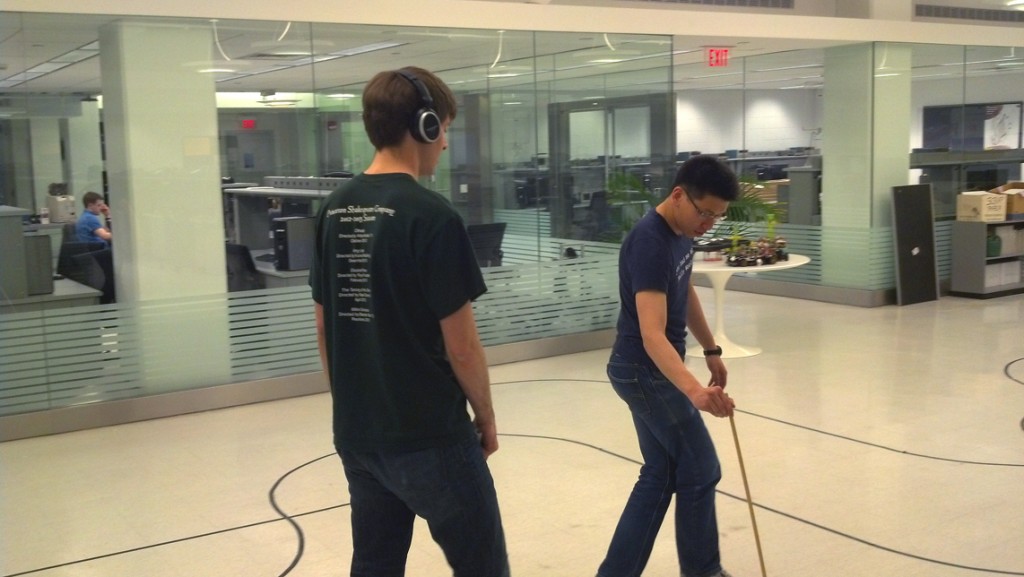Mission Statement
Our mission is to improve the autonomy, safety, and overall level of comfort of blind users as they attempt to navigate their world using cane travel. Our system will accomplish this by solving many of the problems users face when using a traditional long, white cane. Specifically, we will allow users to interact with their GPS devices without having to dedicate their only other free hand to its use by integrating Bluetooth functionality into the cane itself, and our system of haptic feedback will allow users to receive guidance that is perfectly clear even in a noisy environment and does not distract them from listening to basic environmental cues. In addition, the compass functionality we add will allow users to always have an on-demand awareness of their cardinal orientation, even indoors where their GPS does not function. Finally, because we recognize the utility that traditional cane travel techniques have come to offer, our system will perform all of these functions without sacrificing any of the use or familiarity of the standard cane.
Description of tasks
1. Navigating an Unfamiliar Path While Carrying Items:
We will have our users perform the tests while carrying an item in their non-cane hand. To replicate how the task would actually be performed from start to finish, we will first have the user announce the destination which they are to reach aloud (as they would using hands-free navigation), and then via “Wizard of Oz” techniques we will provide the turn-by-turn directions.
We did a few test-runs in the ELE lab and found that it was necessary to dampen the extra noise created by our wizardry. The video below is a quick example of the method we will use when testing the prototype with users.
And the same method while carrying an item in the other hand:

2. Navigating in a Noisy Environment:
An important aspect of the design was to eliminate the user’s dependence on audio cues and allow them to pay attention to the environment around them. Likewise, we recognized that some environments (e.g. busy city streets) make navigating with audio cues difficult or impossible. In order to simulate this in our testing, we will ask the user to perform a similar navigation task as in Task 1 under less optimal conditions: the user will listen to the ambient noise of a busy city through headphones.

3. Navigating an Unfamiliar Indoor Space:
When navigating a large indoor space without “shorelinable” landmarks, the user uses the cane to maintain a straight heading as they traverse the space, and to maintain their orientation as they construct a mental map of the area. With our prototype, the user will be told that a landmark exists in a specific direction across an open space from their current location. They will attempt to reach the landmark by swinging their cane to maintain a constant heading. A tester will tap the cane each time the user swings it past geographic north, simulating the vibration of a higher-fidelity prototype. The user will also have the option to “set” a direction in which they’d like the tap to occur by initially pointing their cane in a direction, and will be asked to evaluate the effectiveness of the two methods. The user will be asked to explore the space for some time, and will afterwards be asked to evaluate the usefulness of the cane in forming their mental map of the area.
Description of prototype
Our prototype consists of a 4ft PVC pipe, and a padded stick meant to provide tactile feedback without giving additional auditory cues. The PVC pipe is meant to simulate the long white cane used by blind people. The intended functionality of the product is to have the cane vibrate when the user swings the cane over the correct direction (e.g., north). To simulate vibration of the cane when it passes over a cardinal direction, we use the padded stick to tap the PVC pipe when it passes over the intended direction.
How did you make it?
The PVC pipe is used as-is. The padded stick is just a stick with some foam taped to its end as padding.
Other prototyping techniques considered
We considered taping a vibrating motor to the PVC pipe and having a tester control the vibration of the motor through a long wire when the user is swinging the PVC pipe. However, we realized it would not work well since the user would be swinging the pipe quite quickly, and it would be hard for the tester to time the vibration such that the pipe vibrates when it’s pointing in the right direction.
What was difficult?
This prototype was really simple to build.
What worked well?
The foam padding worked well to provide tactile feedback without giving additional auditory feedback.
Group Members: Joseph Bolling, Jacob Simon, Evan Strasnick, Xin Yang Yak
